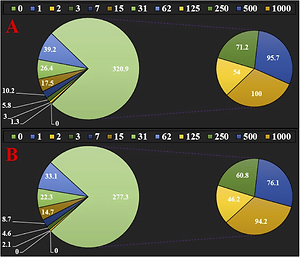Current issue
Archive
Manuscripts accepted
About the Journal
Editorial office
Editorial board
Section Editors
Abstracting and indexing
Subscription
Contact
Ethical standards and procedures
Most read articles
Instructions for authors
Article Processing Charge (APC)
Regulations of paying article processing charge (APC)
ONCOLOGY / RESEARCH PAPER
Proapoptotic protein Smac mediates apoptosis in ovarian cancer cells when treated with carpachromene
1
Department of Gynaecology, Ganzhou People’s Hospital, Ganzhou, Jiangxi, China
2
Pathology Department, Ganzhou Cancer Hospital, Ganzhou, Jiangxi, China
Submission date: 2021-10-16
Final revision date: 2021-10-30
Acceptance date: 2021-11-01
Online publication date: 2021-11-07
Corresponding author
KEYWORDS
TOPICS
ABSTRACT
Introduction:
We investigated carpachromene in cytotoxicity studies against a common human ovarian cancer cell line, i.e. SW 626, in vitro. Interestingly, we obtained significantly good results in the study. Also, we performed enzyme inhibition and molecular docking studies.
Material and methods:
For investigating the antioxidant properties of carpachromene, the DPPH test was used in the presence of butylated hydroxytoluene as the positive control. Cell viability of carpachromene was very low against the common human ovarian cancer cell line SW 626 without any cytotoxicity on a normal cell line. To compare the biological activities of molecules, the enzymes used were α-glucosidase, acetylcholinesterase, respectively. Finally, calculations were made using the molecular docking method to compare the biological activity of the carpachromene molecule. We then examined whether the release of Smac is necessary for apoptosis in ovarian cancer cells using the SW 626 cell line. We first examined mitochondrial and cytosolic Smac levels after carpachromene treatment.
Results:
Carpachromene inhibited half of the DPPH molecules in the concentration of 103 µg/ml. Maybe significant anti-human ovarian cancer potential of carpachromene against common human ovarian cancer cell lines is linked to their antioxidant activities. Following the docking calculations, the properties of the carpachromene molecule were examined by ADME/T analysis in order to be used as a drug in the future. In addition, the anti-oxidant properties of the molecules were examined in both gas and water phases with the HF/6-31g basis set with the Gaussian software program. It was found that exposure of ovarian cancer cells to carpachromene decreased mitochondrial Smac and increased cytosolic Smac levels in a time-dependent fashion. The results showed a decrease in Smac expression, as confirmed by Western blot. Silencing of Smac significantly inhibited carpachromene-induced caspase-3 cleavage and attenuated apoptosis in these cells. Moreover, overexpression of a Smac heptapeptide (Smac-N7) enhanced carpachromene-induced cell death.
Conclusions:
According to the above findings, carpachromene may be administered for the treatment of several types of human ovarian cancer in humans.
We investigated carpachromene in cytotoxicity studies against a common human ovarian cancer cell line, i.e. SW 626, in vitro. Interestingly, we obtained significantly good results in the study. Also, we performed enzyme inhibition and molecular docking studies.
Material and methods:
For investigating the antioxidant properties of carpachromene, the DPPH test was used in the presence of butylated hydroxytoluene as the positive control. Cell viability of carpachromene was very low against the common human ovarian cancer cell line SW 626 without any cytotoxicity on a normal cell line. To compare the biological activities of molecules, the enzymes used were α-glucosidase, acetylcholinesterase, respectively. Finally, calculations were made using the molecular docking method to compare the biological activity of the carpachromene molecule. We then examined whether the release of Smac is necessary for apoptosis in ovarian cancer cells using the SW 626 cell line. We first examined mitochondrial and cytosolic Smac levels after carpachromene treatment.
Results:
Carpachromene inhibited half of the DPPH molecules in the concentration of 103 µg/ml. Maybe significant anti-human ovarian cancer potential of carpachromene against common human ovarian cancer cell lines is linked to their antioxidant activities. Following the docking calculations, the properties of the carpachromene molecule were examined by ADME/T analysis in order to be used as a drug in the future. In addition, the anti-oxidant properties of the molecules were examined in both gas and water phases with the HF/6-31g basis set with the Gaussian software program. It was found that exposure of ovarian cancer cells to carpachromene decreased mitochondrial Smac and increased cytosolic Smac levels in a time-dependent fashion. The results showed a decrease in Smac expression, as confirmed by Western blot. Silencing of Smac significantly inhibited carpachromene-induced caspase-3 cleavage and attenuated apoptosis in these cells. Moreover, overexpression of a Smac heptapeptide (Smac-N7) enhanced carpachromene-induced cell death.
Conclusions:
According to the above findings, carpachromene may be administered for the treatment of several types of human ovarian cancer in humans.
We process personal data collected when visiting the website. The function of obtaining information about users and their behavior is carried out by voluntarily entered information in forms and saving cookies in end devices. Data, including cookies, are used to provide services, improve the user experience and to analyze the traffic in accordance with the Privacy policy. Data are also collected and processed by Google Analytics tool (more).
You can change cookies settings in your browser. Restricted use of cookies in the browser configuration may affect some functionalities of the website.
You can change cookies settings in your browser. Restricted use of cookies in the browser configuration may affect some functionalities of the website.



